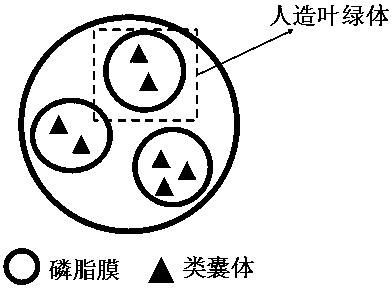Preparation method of thylakoid-containing artificial cells and photosynthesis simulating method
A thylakoid, artificial technology, applied in the fields of biochemistry, biotechnology, and synthetic biology, which can solve the problem of not being able to double-simulate
- Summary
- Abstract
- Description
- Claims
- Application Information
AI Technical Summary
Problems solved by technology
Method used
Image
Examples
specific Embodiment approach 1
[0017] Specific implementation mode 1: This implementation mode records a method for preparing artificial cells containing thylakoids, and the steps of the method are as follows:
[0018] Step 1: extract thylakoid particles: extract thylakoid particles from fresh spinach leaves, and store them in a buffer solution for later use;
[0019] Step 2: Preparation of GUV solution: apply the phospholipid solution on the ITO glass electrode, form a layer of phospholipid film after the solvent evaporates, fix the PTFE frame with vacuum grease, add liquid phase inside the PTFE frame, and prepare There is an ITO glass electrode with a layer of phospholipid film to add alternating current to prepare GUV solution;
[0020] Step 3: Preparation of thylakoid-containing artificial cells: mix the GUV solution prepared in step 2 with the solution containing thylakoid particles in step 1, and under the action of osmotic pressure, prepare thylakoid-containing artificial cells with complete structur...
specific Embodiment approach 2
[0021] Specific embodiment two: the preparation method of a thylakoid-containing artificial cell described in specific embodiment one, the specific steps of step one are: clean the spinach leaves, control the water; mix the spinach leaves with B1 buffer solution and Grind the spinach in a blender, wherein the mass volume ratio of the spinach leaf to the B1 buffer solution is 1:4g / mL, and the crushing time is 20min; then filter the mixture with 6-8 layers of gauze, and the filtrate is 6000rpm at 4°C Centrifuge 15min in centrifuge to collect complete and broken chloroplast; Add B2 buffer solution to the sediment and process 20min in the cell disruptor to break the chloroplast membrane, wherein the mass volume ratio of the sediment to B2 buffer solution is 1: 50g / mL; subsequently, centrifuge in a centrifuge at 10000rpm at 4°C for 15min, and add B3 buffer solution to the precipitate, wherein the mass volume ratio of the precipitate to B3 buffer solution is 1:50g / mL, and the finally...
specific Embodiment approach 7
[0026] Embodiment 7: A method for simulating photosynthesis using artificial cells containing thylakoids prepared in Embodiment 1. The specific steps of the method are: draw 14 mL of artificial cell solution containing thylakoids, and the concentration of chlorophyll therein It was 2.6mg / mL, irradiated for 2 h at 20°C and 250W xenon lamp to carry out photosynthesis, after photosynthesis, add 0.7mL of 2wt.% Triton X-100 (polyethylene glycol octylphenyl ether) to the mixed solution ) at 25°C for 10 min to break the phospholipid membrane and release the liquid in the vesicles, then add 10 mL of 10% trichloroacetic acid solution to terminate the redox reaction; then centrifuge at 3000 rpm for 10 min, take 1.5 mL of the supernatant and add 1.5 mL of distilled water and 0.1 mL of ferric chloride solution with a mass concentration of 0.1% were kept in a water bath at 25 °C for 10 min; then, the absorption value at 680 nm was measured with an ultraviolet absorption spectrophotometer.
PUM
 Login to View More
Login to View More Abstract
Description
Claims
Application Information
 Login to View More
Login to View More - R&D
- Intellectual Property
- Life Sciences
- Materials
- Tech Scout
- Unparalleled Data Quality
- Higher Quality Content
- 60% Fewer Hallucinations
Browse by: Latest US Patents, China's latest patents, Technical Efficacy Thesaurus, Application Domain, Technology Topic, Popular Technical Reports.
© 2025 PatSnap. All rights reserved.Legal|Privacy policy|Modern Slavery Act Transparency Statement|Sitemap|About US| Contact US: help@patsnap.com

